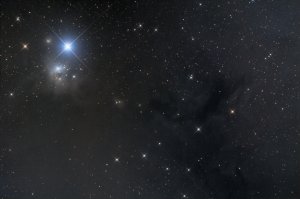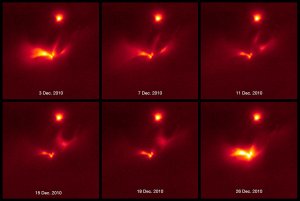

If you love a good party, then you might want to head on over to IC 348, a star forming region located some 950 light-years from Earth (okay, so it might be a long trip…but it’ll be worth it). At first glance, this cloudy disk of dust seems pretty ordinary. However, it’s hiding something spectacular: an infant star that acts like a strobe light.
LRLL 54361 is a protostar that gives off a super-stellar burst of light at a precise interval, unleashing an unbelievable amount of energy every 25.34 days (so your rave will actually be more like months of utter darkness broken up by momentary bursts of blinding light…but really, when it comes to cosmic parties, beggars can’t be choosers).
SPACE RAVE:

Astronomers hypothesize that the binary protostars found in the center of IC 348 drag material from the inner edge of a surrounding disk as they orbit one another. It is believed that this material ultimately crashes onto one or both stars, which triggers the flash of light. However, infant stars that have such a regular and precise increase in luminosity are exceedingly rare. As a result, LRLL 54361 has left scientists a little baffled.
Since it is only a few hundred thousand years old, LRLL 54361 is still at the beginning stages of its life. As a result, astronomers are hopeful that this stellar object will offer new insights into the formation and evolution of stars. Additionally, although a similar phenomenon has been observed in two other instances, this is the most powerful beacon seen to date. So this provides us with a new opportunity to monitor how such phenomena operate.
THE PARTY RAGES ON IN DIFFERENT WAVELENGTHS:
To get a complete picture of the on-going activity, several different telescopes have been pointed in the general vicinity of the party animal. This image is a collage showing two real images of LRLL 54361. In the first (on the far left), we have a false-color, infrared-light image of LRLL 54361, which was captured by the Spitzer Space Telescope. In the second (center) image, we see a monochromatic-colored image of the region, taken by the Hubble Space Telescope’s keen eye. This one is highly effective in helping us resolve the detailed structure of the protostar, like the cavities (shaped by fierce stellar winds),where light runs throughout the dusty disk.

On the far right, we see an artist’s rendering of of the central objects, showing the hypothesized different stars. The pulsations of said stars are likely the result of raw material found in the circumstellar disk sporadically, but naturally, falling into the disk as the stars continue to evolve. Each time this happens, a burst of radiation is released.